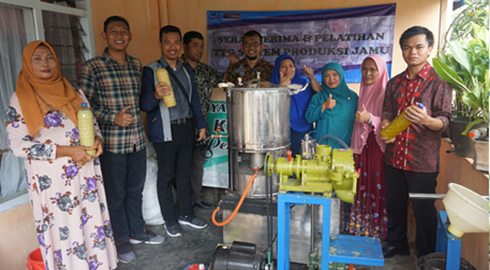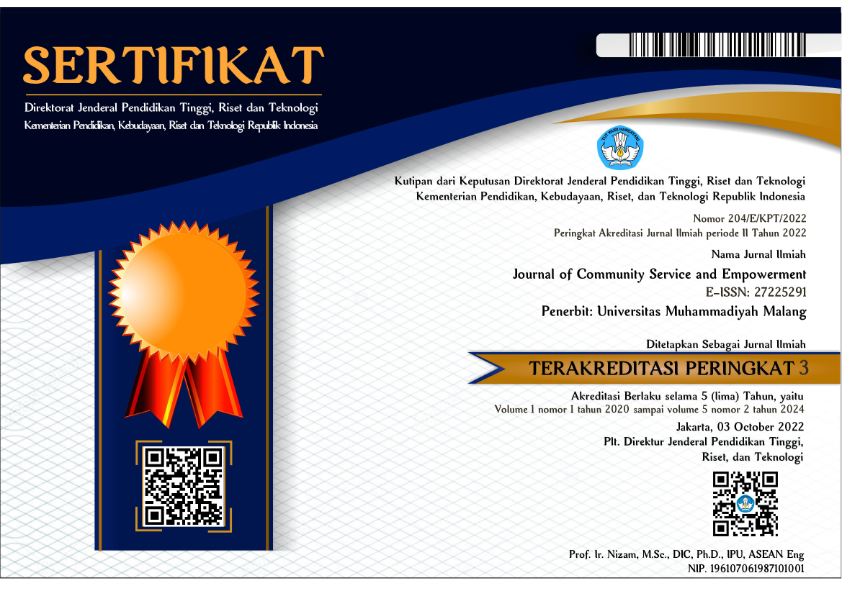Improving the hygiene of jamu sellers in Malang through the provision of appropriate technology
DOI:
https://doi.org/10.22219/jcse.v2i3.16541Keywords:
Appropriate technology , Herbal medicine, Hygiene, JamuAbstract
Jamu (herbal medicine) is included in traditional health drinks that its processing is often less hygienic. The purpose of this community service program is to improve the cleanliness of the herbal medicine-making process in the herbal medicine group in Malang through the provision of hygienic herbal medicine processing machines. Community service activities were carried out in 2018 by involving herbal medicine groups in Tegalgondo and Jetis Villages, Malang. The community service activities included analyzing the conditions and needs of partners, designing herbal medicine machines as needed, as well as assisting the use of machines. The implementation methods in this service program were discussion and training. The result of this service activity was an increase in partner knowledge regarding the importance of hygiene and the use of appropriate technology in herbal medicine processing. After the training was carried out, service partners began to be moved to process jamu more hygienically. Furthermore, assistance and technology-based marketing training activities also need to be carried out.
Downloads
References
Ahmed, H. G. (2012). Cancer awareness survey on exposure and attitude toward the commonn chemical carcinogenes in Northern State of Sudan. Management in Health, 9–12. http://journal.managementinhealth.com/index.php/rms/article/viewFile/247/774
Alalwan, A. A., Rana, N. P., Dwivedi, Y. K., & Algharabat, R. (2017). Social media in marketing: A review and analysis of the existing literature. Telematics and Informatics, 34(7), 1177–1190. https://doi.org/10.1016/j.tele.2017.05.008
Aneja, K. R., Dhiman, R., Aggarwal, N. K., & Aneja, A. (2014). Emerging preservation techniques for controlling spoilage and pathogenic microorganisms in fruit juices. International Journal of Microbiology, 2014. https://doi.org/10.1155/2014/758942
Baroni, S., Aparecida, I., Patera, R., de Moura, A. C., Silva Pinto, F. G. da, & Sartori Cardoso da Roch, C. L. de M. (2013). Microbiological contamination of homemade food. In I. Muzzalupo (Ed.), Food Industry. InTech. https://doi.org/10.5772/53170
Basri, B., & Assidiq, M. (2019). Peningkatan kualitas produksi melalui transformasi Kemasan produk pada usaha pembuatan jamu kunyit. CARADDE: Jurnal Pengabdian Kepada Masyarakat, 2(1), 139–143. https://doi.org/10.31960/caradde.v2i1.264
Devi, R. (2015). Food processing and impact on nutrition. Sch J Agric Vet Sci., 2(4A), 304–311. http://saspjournals.com/wp-content/uploads/2015/08/SJAVS-24A304-311.pdf
Elfahmi, Woerdenbag, H. J., & Kayser, O. (2014). Jamu: Indonesian traditional herbal medicine towards rational phytopharmacological use. Journal of Herbal Medicine, 1–23. https://doi.org/10.1016/j.hermed.2014.01.002
Fhitryani, S., Suryanto, D., & Karim, A. (2017). Pemeriksaan Escherichia coli, Staphylococcus aureus dan Salmonella sp. pada jamu gendong yang dijajakan di Kota Medan. BioLink, 3(2), 142–151. http://ojs.uma.ac.id/index.php/biolink/article/download/845/821
Fillion, L., & Henry, C. J. K. (1998). Nutrient losses and gains during frying: A review. International Journal of Food Sciences and Nutrition, 49(2), 157–168. https://doi.org/10.3109/09637489809089395
Gunawan, R., & Mustofa, K. (2017). Finding knowledge from Indonesian traditional medicine using semantic web rule language. International Journal of Electrical and Computer Engineering (IJECE), 7(6), 3674–3682. https://doi.org/10.11591/ijece.v7i6.pp3674-3682
Halden, R. U. (2010). Plastics and health risks. Annual Review of Public Health, 31(1), 179–194. https://doi.org/10.1146/annurev.publhealth.012809.103714
Hamad, S. H. (2012). Factors affecting the growth of microorganisms in food. In R. Bhat, A. K. Alias, & G. Paliyath (Eds.), Progress in Food Preservation (pp. 405–427). John Wiley & Sons. https://doi.org/10.1002/9781119962045.ch20
Hernández-Cortez, C., Palma-Martínez, I., Gonzalez-Avila, L. U., Guerrero-Mandujano, A., Solís, R. C., & Castro-Escarpulli, G. (2017). Food poisoning caused by bacteria (Food toxins). In N. Malangu (Ed.), Poisoning - From Specific Toxic Agents to Novel Rapid and Simplified Techniques for Analysis. InTech. https://doi.org/10.5772/intechopen.69953
Klug, W. S., Cummings, M. R., Spencer, C. A., & Palladino, M. A. (2012). Concepts of Genetics (10th ed.). Benjamin Cummings.
Lailiyah, M., Mulyati, T. A., & Pujiono, F. E. (2020). Pelatihan pembuatan jamu mix dan jahe wangi pada kelompok ibu rumah tangga di Desa Badal Pandean. Jurnal ABDINUS : Jurnal Pengabdian Nusantara, 3(2), 194–203. https://doi.org/10.29407/ja.v3i2.13730
Leeflang, P. S. H., Verhoef, P. C., Dahlström, P., & Freundt, T. (2014). Challenges and solutions for marketing in a digital era. European Management Journal, 32(1), 1–12. https://doi.org/10.1016/j.emj.2013.12.001
Maulan, R., & Fikriah, V. (2020). Edukasi pengemasan dan pemasaran bagi penjual jamu gendong di Lebak Bulus, Cilandak Jakarta Selatan. Seminar Nasional Pengabdian Masyarakat LPPM UMJ, 1–10.
Mills, J., Donnison, A., & Brightwell, G. (2014). Factors affecting microbial spoilage and shelf-life of chilled vacuum-packed lamb transported to distant markets: A review. Meat Science, 98(1), 71–80. https://doi.org/10.1016/j.meatsci.2014.05.002
Natadjaja, L., Tripoli, F., & Wahyono, B. (2014). The ideal female body on the packaging design of traditional medicine (jamu). Journal of Arts and Humanities (JAH), 3(4), 51–59.
Otemuyiwa, I. O., Falade, O. S., & Adewusi, S. R. A. (2018). Effect of various cooking methods on the proximate composition and nutrient contents of different rice varieties grown in Nigeria. International Food Research Journal, 25(2), 747–754. http://www.ifrj.upm.edu.my/25 (02) 2018/(42).pdf
Primatika, R. A., Nugroho, W. S., & Abadi, R. D. (2015). Analisis cemaran Staphylococcus aureus pada gelas, darah segar, dan jamu dengan ramuan darah ular kobra Jawa (Naja sputatrix). Jurnal Sain Veteriner, 33(2), 190–194. https://jurnal.ugm.ac.id/jsv/article/download/17918/14681
Rahardjanto, A., Nurwidodo, N., & Mas’odi, M. (2019). Implementasi teknologi tepat guna untuk mengatasi permasalahan IRT ramuan Madura di Kabupaten Sumenep. International Journal of Community Service Learning, 3(4), 173–185. https://doi.org/10.23887/ijcsl.v3i4.21788
Rangaswamy, A., Moch, N., Felten, C., van Bruggen, G., Wieringa, J. E., & Wirtz, J. (2020). The role of marketing in digital business platforms. Journal of Interactive Marketing, 51, 72–90. https://doi.org/10.1016/j.intmar.2020.04.006
Rawat, S. (2015). Food spoilage: Microorganisms and their prevention. Asian Journal of Plant Science and Research, 5(4), 47–56. http://www.imedpub.com/articles/food-spoilage-microorganisms-and-their-prevention.pdf
Si, S. (2015). Social media and its role in marketing. Business and Economics Journal, 7(1), 1–5. https://doi.org/10.4172/2151-6219.1000203
Snustad, D. P., & Simmons, M. J. (2012). Genetics. Wiley.
Suci Asriani, P., Bonodikun, & Yuliarti, E. (2015). Pemberdayaan perempuan pengrajin jamu gendong melalui penerapan teknologi diversivikasi produk olahan. Jurnal Bisnis Tani, 1(1), 1–4. https://doi.org/10.35308/jbt.v1i1.583
Sukmawati, P. A., Proborrini, M. W., & Kawuri, R. (2012). Identifikasi fungi dan total bakteri pada jamu tradisional di pasar kedonganan Kelurahan Jimbaran Kabupaten Badung Provinsi Bali. Jurnal Biologi, 16(2), 31–35. http://thescipub.com/pdf/10.3844/ojbsci.2017.285.289
Torri, M. C. (2013). Knowledge and risk perceptions of traditional jamu medicine among urban consumers. European Journal of Medicinal Plants, 3(1), 25–39. http://www.journalrepository.org/media/journals/EJMP_13/2012/Dec/1354796054-Torri_312012EJMP1813.pdf
Tyagi, S. B., Kharkwal, M., & Saxena, T. (2015). Impact Of Cooking On Nutritional Content Of Food. DU Journal of Undergraduate Research and Innovation, 1(3), 180–186. http://journals.du.ac.in/ugresearch/pdf-vol3/U18.pdf
Uçar, A., Yilmaz, M. V., & Çakiroglu, F. P. (2016). Food safety – Problems and solutions. In H. A. Makun (Ed.), Significance, Prevention and Control of Food Related Diseases. InTech. https://doi.org/10.5772/63176
Valero, A., Carrasco, E., & Ma, R. (2012). Principles and methodologies for the determination of shelf-life in foods. In Trends in Vital Food and Control Engineering (pp. 3–42). InTech. https://doi.org/10.5772/35353
Verma, R., Vinoda, K. S., Papireddy, M., & Gowda, A. N. S. (2016). Toxic pollutants from plastic waste- A review. Procedia Environmental Sciences, 35, 701–708. https://doi.org/10.1016/j.proenv.2016.07.069
Wadjdi, M. F., Cahyaning Thias, T. A., Qatrunnada, L., Asga, I. D., Ni’mah, M., Makruf, A., R. Hadiyansa, F., Febriansyah, A. W., Efendi, A., Alfadlilatul Azza, M. W., & Choiruddin, A. (2020). Pengembangan jamu olahan rumah tangga untuk meningkatkan perekonomian masyarakat melalui pemasaran e-commerce. Jurnal Pembelajaran Pemberdayaan Masyarakat (JP2M), 1(2), 143. https://doi.org/10.33474/jp2m.v1i2.6506
Wareing, P., & Davenport, R. R. (2005). Microbiology of soft drinks and fruit juices. Chemistry and Technology of Soft Drinks and Fruit Juices, November 2007, 279–297. https://doi.org/10.1002/9780470995822.ch11
Widyowati, R., Kusumawati, I., Ekasari, W., & Purwitasari, N. (2018). Pengembangan produksi jamu dan bahan spa bagi penjual jamu gendong dan simplisia di Bantul, Yogyakarta. Jurnal Pengabdian Kepada Masyarakat, 2(4), 346–349.
Wijaya, I. (2012). Socio-cultural knowledge and perceptions of jamu consumption risk: Local wisdom of urban Javanese community and its relation to the integration of traditional jamu medicine into formal health system in Indonesia. JKM, 11(2), 129–139.
Wijaya, S. H., Tanaka, Y., Hirai, A., Afendi, F. M., Batubara, I., Ono, N., Darusman, L. K., & Kanaya, S. (2016). Utilization of KNApSAcK family databases for developing herbal medicine systems. Journal of Computer Aided Chemistry, 17, 1–7. https://www.jstage.jst.go.jp/article/jcac/17/0/17_1/_pdf
Yulagustinus, & Tridjaja, N. O. (2017). Jamu—A healthy drink of Indonesia. Journal of Food Science and Engineering, 7, 221–226. https://doi.org/10.17265/2159-5828/2017.04.007
Zuhrie, M. S., Purbodjati, P., & Drastiawati, N. S. (2018). Peningkatan produktivitas UKM jamu tradisional melalui penerapan mesin pengupas rempah-rempah. Jurnal Pengabdian Kepada Masyarakat, 2(4), 285–288.

Downloads
Published
How to Cite
Issue
Section
License
Copyright (c) 2021 Nurwidodo et al

This work is licensed under a Creative Commons Attribution-ShareAlike 4.0 International License.













